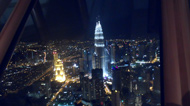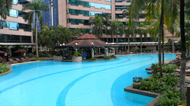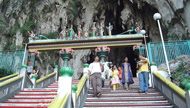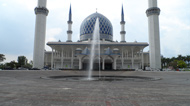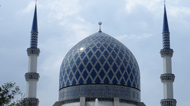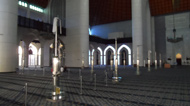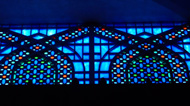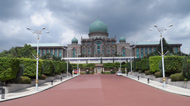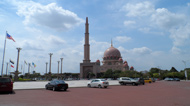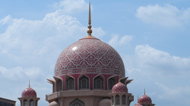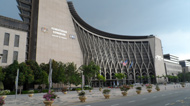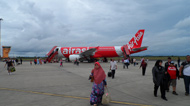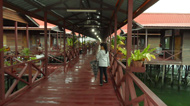 |
Kuala Lumpur is the biggest town in Malaysia and the capital of the Federation. Inside Malaysia the name is often shortened with KL. Recently the government's offices have been moved to Putrajaya, but the residence of the head of state (Yang de-Pertuan Agong), the Parliament and the judicial power have all their seat in Kuala Lumpur. KL is one of the three Federal Territories of Malaysia and an enclave in the Selangor ' state. The main airport of the country is Kuala Lumpur (or KLIA).
The town has been founded in 1857 at the convergence of the rivers Gombak and Kelang, and in Malay language the name means "muddy convergence". The settlement started prospering when Raja Abdullah, a member of the royal family of Selangor, opened the Kelang valley to mineral researches. With the growth of the town, the United Kingdom which dominated the Malaysia of that period appointed a representative (called the Captain of the Chinese) to manage the settlement. The first one was Hiu Siew, but it was the third captain, Yap Ah Loy, that the town enlarged to become the most important in Selangor. In this phase, Kuala Lumpur was in the centre of the Selangor civil war and was devastated, but later it was rebuilt by Yap and ripopulated with Chinese miners coming from other zones of the state. It was in 1880 that the town became the capital of Selangor and in 1896 of the Federated States of Malaysia. During the Second world war the forces of the Japanese empire invaded and occupied the town for a short period in 1942. After the indipendence in 1957 (in Malay merdeka, from which the name of the main square), Kuala Lumpur was chosen as capital of the Federation of Malaysia in 1963. In 1974 the town was separated from Selangor to become a Federal Territory. The eighties and nineties represented the economic and building boom, but did not completely cancel the past. Still nowadays the 1.6 million inhabitants in Kuala Lumpur, or as it is generally called KL, proudly show the cultural and traditional differences of Malay, Chinese and Indian cultures, that nevertheless coexist in a more peaceful way than in other realities.
The attractions not to be lost are the Petronas Towers (452 meters) that represent the symbol of the town and are still today the highest twin towers in the world. The tower of Kuala Lumpur is better known by the local population as "KL tower" and is located in the centre of the Malay capital, in the so called "Golden Triangle", not far from Bukit Bintang and from the Twin towers, of more recent contruction. The tower was commenced in the 4th of Oktober 1991 and was completed in 1995, and is considered as the 7th highest tower in the world, with its total height of 421 meters, antenna included.
It was built on the hill called Bukit Nanas, in three different phases: 1) the achievement of the foundations; 2) the achievement of the basement, during which were poured 50.000 sq. meters of cement in 31 hours - at that time a rekord for the Malay building industry; 3) the last phase was the construction of the today's structure of the tower, also carried out in record time of 8 months.
The tower shelters in its interior an observatory of the lunar phases, called Falak, which announces every year the beginning of the Ramadan, the muslim fast holiday of one month (the muslim calendar is of moon type). The visitors can go to the panoramic floor on the top till late in the evening and dine in the rotating panoramic restaurant, booking at least one day before. The mosque Masjid Jamek, built in 1909 on the confluence between the rivers Gombak and Klang, flanked with palms, in the zone of Little India, is characterized of a wonderful hindo-muslim design and is one of the must ancient mosques in town. The Central Market in bazar style was opened in 1936. A modern restoration has allowed to join many stalls of handicraft. There are sculptures, silk and masks with fresh products and the historical inheritance of this old market in the centre of the town. The Lake Gardens, where jogging, picnic lovers and couples hand in hand like to go, 92 hectars of size, located on an artificial lake on the west side of the Colonial District. The parc shelters the zone of the birds, the orchids' garden, the butterfly park and the insect museum. Out of the town, the Batu Caves are holy limestone caves, in Selangor, 400 million-year old and they represent the holiest hindu place outside India. Centre of interest of the Thaipusam Festival, where millions of pilgrims climb the 272 steps of Batu Caves till the top of the hill every year. In town you can move by monorail (RM 1.20 > 2.40), by metro or by taxi (RM 3 initial tarif for ordinary taxi, RM 6 for luxury taxi). To go to Singapore you can go to TBS (Terminal Bersepadu Selatan, www.tbsbts.com.my), the new bus station to different destinations. By taxi from Renaisance Hotel to TBS you spend about RM 40 and it takes about 40'. From KL Sentral you can catch the Komuter train which costs only RM 1. There are many luxury bus companies (18/21 places). With Five Stars the ticket costs RM 45 (€ 10) one way and takes about 6.5 hours. During the journey the bus stops for lunch/toilet half hour. After the arrival at the border, the passport control is carried out, and after that the customs control (Woodlands checkpoint). It is compulsory to bring along all suitcases and bags. Pay attention to alcohol, wine and tobacco: they must be declared and taxes must be paid in order to avoid the high fines. All buses stop in Beach Road, in front of the Golden Mile, from where is possible to catch a taxi to the hotel. From Beach Road to the Regent Hotel the cost is about S$ 13. To go back to KL the ticket is more expensive from Singapore: S$ 43 (€ 25). It always takes about 6.5 hours to go back to KL. To fly to many destinations in Asia you can use Air Asia, low cost carrier. All flights live from LCCT (low cost carrier terminal) near the international airport of KL. A non-stop bus service links KL Sentral to LCCT: buses leave every half hour, 0.00 and 0.30, and cost RM 10 p.p./1h (www.skybus.com.my); on line the ticket costs only RM 8.50. Furthermore there is a bus link from LCCT to the international airport KL for RM 1.50 and with departure every half hour.
The Selangor, whose capital is Shah Alam (646,000 inhabitants), has a surface of 7,956 sq. Km. and a population of about 5 millions 400 thousand inhabitants (2010). Selangor was part of the Malacca's reign and in the XVIII century, became a possession of the Bugeneses, coming from Makasar; the wars for the tin deposits that lasted for a great part of the XIX century brought in 1874 to a British protectorate, and in 1896, to the assent to the Malay Federation. The starting development of Selangor was due to the tin and rubber exports and to the coal mining of Batu Arang; the first railroad was built in 1890. In 1948 the State became part of the Malaysia Federation. The main attraction of Shah Alam is the Blue Mosque of Abdul Aziz Shah. It was built between 1982 and 1988. It is called the "Blue Mosque" thanks to its blue dome and is considered as one of the biggest in the world: it has a diameter of 170 feet (51.80 m.) and is 350 feet high (106 m.). The four minarets 460 feet (140 m.) high are the second highest in the world. The mosque has a capacity of 16 thousand believers.
To reach Shah Alam from KL, it is possible to catch the komuter train from KL sentral, 5 RM, A/R, 50' trip. From the Shah Alam station you catch a taxi that with RM 8 takes you to the mosque, which you can visit free, and if clothes do not comply with what is requested, at the entrance you will receive a jallabiah to cover yourself. Furthermore, a local guide will accompany visitors around giving information about the mosque.
Putrajaya is a town located on the south of Kuala Lumpur and is the new administrative federal centre of Malaysia. Many government offices have been moved here to face the overcrowding and the congestion of Kuala Lumpur. Nevetheless, KL is still the national and legislative capital. It has a surface of 49 sq. Km. and a population of 70 thousand inhabitants.
The town has been called like this in honour of the Prime Minister Malay, Tunku Abdul Rahman Putra. In Malay language the words "Putra" mean prince and "Jaya" excellent or success.
The town has been built on a completely out of proportion scale with its actual population, with a series of bridges that cross an artificial lake, the Putrajaya lake. There are two ways to reach Putrajaya: by train or by bus. By train with KLIA Transit, which costs RM 9.50, with a frequency of every half hour and it takes only 17'. The trip by bus E1 from KL Sentral to Putrajaya is a little bit longer, about 50', costs RM 3.80 and leaves from Pasar Seni, behind Petaling street. In order to move in town the local bus costs only RM 0.50. You pay the driver in the bus.
Pom Pom Island is located at less than an hour boat ride from the dry land of Borneo, is an island rich of tropical vegetation, with a large beach of white sand and is surrounded by the crystal waters of Celebes. The atoll is only 25 hectars, and with the near islands of Sipadan, Kapalai, Mataking and Mabul forms the Marine Park of Semporna. The island is located on one of the coral areas considered as among the richest in the world. The resort of very recent contruction (2008) offers the ideal vacation for any kind of clientele: scuba divers, non divers, honeymooners, families, snorkeling and sun lovers. All bungalows have been built with the concept to give to all guests their own privacy with all comforts an ideal holiday needs. The voluntary choice of sober material and the limited number of constructions, at the moment 31, give to the resort a unique touch of culture and local design. Pom Pom island resort is very proud to be the only resort in this area to have a system of water purification of reverse osmosis. The rain water is collected in big containers in order to be filtered and purified through a system of ultraviolet rays which allows to have in the rooms drinking water from the tap. The first water waste will be recycled and used for the irrigation of the gardens. On the contrary, black waters are collected in different containers and involved in a system of natural evaporation. The clientele is mainly Asian (Chinese and Japanese) and Russian. Italian guests are only a few. The breakfast, lunch and dinner are served at the buffet and plates are basically of Chinese cuisine. The staff in the restaurant is however available to satisfy different culinary personal needs. To reach the island the main link is Tawau Airport, which is 30 Km. far away from town. From the airport it is possible to reach by car or minivan the Semporna village, a small fishermen' s village, 80 Km/1h30' far away. The taxi costs RM 150. There is also the local bus service. Then, from Semporna, three times a day, the island can be reached by speedboat in 45' trip. The temperature remains more or less constant all the year long: the temperature of the air is around 26/32° C., the water is between 28/30° C.. The diving lovers cannot miss to dive in Magic Rock, a rock in the reef, where are visible turtles, glass fishes, scorpion fishes and many others. The wall divings are also very charming, as for instance D' Wall, where you can easily meet barracudas, barrier sharks, etc. What marks Pom Pom is the very rich biodiversity, with the typical tropical vegetation which shelters earth and marine fauna of incomparable beauty: the island offers also the possibility to observe from near the turtles, which lay eggs on the sand-white beaches. The absolute relax reigns undisputed, as there are no native villages and everything is dedicated to the diving activities. At the Diving centre in Pom Pom works an international staff, Italian speaking as well, very experienced, careful to the safety and always ready to satisfy' guests. The local Dive Masters are very careful to show the small creatures living in the shallow waters, which make every dive always rich of surprises. The base diving package consists of three dives a day with the boat, furthermore you can live extraordinary experiences with night dives. A three dives package costs RM 340, whereas the daily rent of fins, mask and nozzle costs RM 100. A support agency in Kuala Lumpur is Malaysia.com: Tel. +60 3 20355555. Serge Huber is the CEO. The Pom Pom island resort occupies only a part of the island. It is possible to make the tour of the island in about half hour walk.
Outside the village the beach is not clean at all. It is very disappointing to see everywhere: trunks, plastic bottles and bags, cans, glass bottles, etc.
For further information and prices about the resort visit the website: www.pompomisland.com
IMPORTANT: dives in Sipadan Island, organized by the Diving centres in Mabul Island, Kapalai, Mataking, Pom Pom island, are regulated by the Marine Park Local Authorities, and allow a maximum of 120 divers a day. For this reason resorts will not be able to guarantee with certainty to their guests a dive a day in Sipadan. The availability of the dives in Sipadan will be confirmed at the island at the arrival and according to the present divers. The government tax will be paid there at the moment by those who will be entitled to dive.
Exchange rate the 06th of December 2013:
1 € = 4,38 MYR - 1 USD = 3,20 MYR
Hourly difference with Italy: + 7 hours (solar time)
